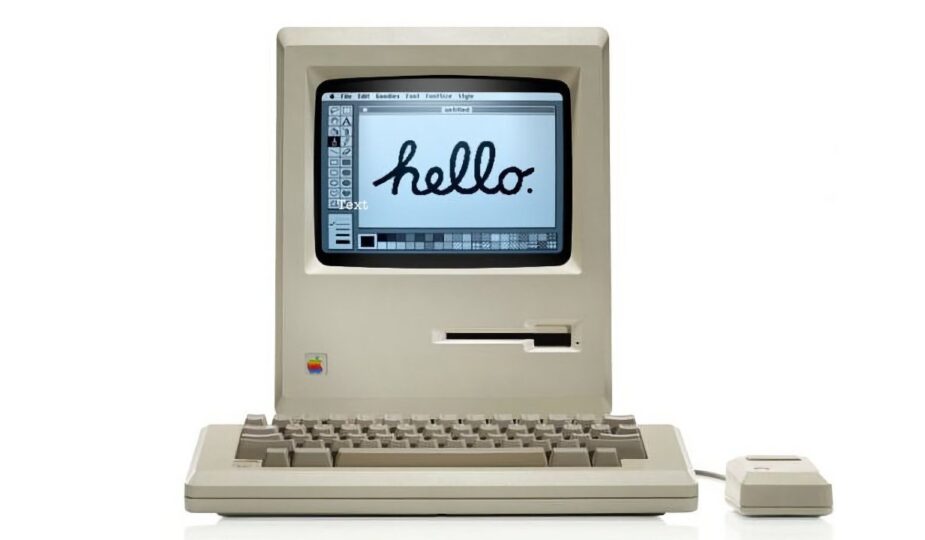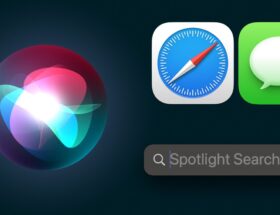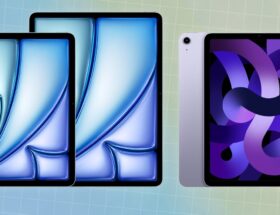Original Macintosh
 2 Facebook x.com Reddit
2 Facebook x.com Reddit
Forty years before the Apple Vision Pro, almost on the same day, Apple released the Macintosh — and it ended up changing the world.
Apple Vision Pro wouldn't exist, and Apple wouldn't be a trillion-dollar company if it weren't for the Mac, released on January 24, 1984. Even though Apple and the world have changed in that time, 40 years later, however, there are striking similarities between what Apple was and what Mac made it.
Beginning in the 1980s, there was still a question about what people would use the computer for. There has always been a claim that they can pay taxes and — get ready to wince — so that housewives can store recipes on them.
In the end, the answer to the question of what people would use a computer for was everything. Everything. Perhaps the same thing will happen with the Apple Vision Pro, but 40 years ago Apple didn't get the same attention as it does now.
And partly because of this, partly because the original Macintosh was far from being fully functional, the Mac did not immediately become one. You could say it was even a failure.
The Apple Macintosh first appeared in the world in 1984
“You just saw some photos of the Macintosh,” Steve Jobs said at the official presentation. Mac on Tuesday, January 24, 1984. “Now I'd like to show you the Macintosh in person.”
He spoke on stage at the Flint Center at De Anza College in Cupertino, which would be the site of many of Apple's most important presentations until it closes in 2019. Like the Mac, this is where the first iMac and Apple Watch were introduced.
The Mac he introduced at the Flint Center back in January 40 years ago has a name we all know and a display that longtime users may remember, but little more.
Its screen was monochrome and 9 inches smaller than any modern Mac. It was only slightly larger than the current 8.3-inch iPad mini.
However, the resolution of today's iPad mini shows how small the original Mac was in another sense. While the iPad mini has a resolution of 2266 x 1488 pixels, the original Mac had only 512 x 342 pixels.
In addition, we can now stream Apple Music using Spatial Audio, then its speaker had difficulty reproducing the voice during Jobs' demo.
While today the original Mac looks primitive, in 1984 it looked like the future.
“Until now,” wrote Steven Levy in his book about the Mac, “when someone said that the computer screen “lit up,” some literary license was required. By the end of the demo, I began to understand that these are the things a computer should do. There was a better way.”
Subscribe to AppleInsider on YouTube
This was the usual reaction of early Mac users, a kind of joyful surprise that it made sense and that they instinctively, automatically knew how do it. to use it. Or rather, they knew what it was like to see a folder, document, or trash bin on the screen, but dragging with the mouse required additional explanation.
Apple released a version of what soon became known as the Electronic Press Kit (EPK) in the 1980s to promote the Mac and provide footage to news outlets for use in their reporting.
As part of the direct, hyped and extended advertising designed to sell the Macintosh, this EPK also managed to reveal the very different views of both Steve Jobs and then-CEO John Sculley.
“We're committed to our vision,” Jobs says in the video. “And we'd rather do that than make 'me too' products.” Let other companies do it.”
Jobs may have regretted it later, after Windows and then Android copied Apple, but that video was the seed of the problems to come.
“With the Macintosh, we developed an extremely well-coordinated and very powerful consumer marketing program to introduce this product,” John Sculley says in the videos.
Sculley believed that marketing was an important factor, and Jobs believed that making the Mac the best it could be was Apple's focus. You can't blame either of them because a great product is useless if no one hears about it, and brilliant marketing can only go so far with a bad product.
But it was 1984, and in 1985 Apple and Jobs broke up.
At that time, it seemed that the inventor of the Mac was no longer there – — except, of course, that he will return. And perhaps Steve Jobs was far from the creator of the Mac.
It all started with Jef Raskin
That doesn’t mean that Jobs had nothing to do with the creation of the Mac since, for example, he was responsible for how it worked with the keyboard and mouse.
It was Steve Jobs who demanded that the Mac not have four cursor keys to move around the screen, so that users were forced to use another of his demands – — mouse.
As a result, the planned 62-key Mac keyboard became a 58-key keyboard, and the mouse became an integral part of absolutely everything users did with the computer.
“I hated the mouse,” Apple's Jeff Raskin told Owen Linzmeier in Apple Confidential 2.0. “Jobs gets 100 percent credit for insisting the Mac have a mouse.”
Raskin may have been wrong about the mouse, and Raskin is also a much lesser known figure than Jobs, but it was crucial for the Macintosh. He even gave the computer a name, although he assumed it would just be a codename while the Mac was in development.
In addition, after seeing Jobs stretch, stretch, and distort his original basic ideas for the Mac, Raskin even worked on a mouse that he disliked so much. If you've ever wondered why the Mac had a mouse with one button while Windows had three or more, it was thanks to Raskin.
Like most things on the Mac, the mouse was created because Jobs saw it in use at Xerox PARC in 1979. But Ruskin was there first, and in fact Ruskin was there often, so he saw the development of the mouse — and he wasn't happy.
“They had a three-button mouse, and I couldn’t keep track of which button was which,” he said in a later television interview. “And so when I came to create the Macintosh project… I realized that everything that needed to be done could be done with a one-button mouse. It took me a while to convince people that it was possible.”
It is no longer clear how Raskin came to create the Mac, since he himself changed the story a little. However, it is most likely that at some point in 1979 he was thinking about the future of Apple and shared his idea with then-chairman Mike Markkula.
“The projects that were in development [at the time] were the Apple III and the Lisa. I [told Markkula that] I thought the Apple III didn't have the technical flair that would allow us to reach that future… and the Lisa was going to be overpriced and too slow. So I came up with a thing I called the Macintosh.”
He also suggested that the Macintosh would be released by Christmas 1981 and would cost $500. He was slightly wrong. for more than two years and just under $2,000.
What Went Wrong with Raskin's Plan
Jeff Raskin proposed almost everything that the Mac eventually became, especially with regard to its bitmap screen, which could display images rather than just lines of green or yellow text. There is no doubt that moving from his plan to the final product would have required so much time and money that Apple would have had to charge over $500.
But ultimately, the two key reasons for the delay and the price being five times Raskin's plan were Steve Jobs and John Sculley.
Jobs was working on the Apple Lisa when he visited Xerox PARC and saw what was being done there. When he returned to Apple and tried to make Lisa more like what Xerox was doing, he was kicked off the Lisa team.
Looking for something else to work on, Jobs decided that the Mac was not the unimportant side project he thought it was and took control.
Canon Cat Ad (Source: Archive.org)
Jobs gradually excluded Jef Raskin from more and more of the Mac design effort. Raskin eventually retired in March 1982 and began building what would become the Canon CAT computer in 1987.
Launching the Mac
It is unlikely that you have heard of Canon CAT and are unlikely to have ever used it — it was discontinued in 1987, the same year it was released. While the Mac was released in 1984 and may have never been discontinued.
Some Mac models, almost all of them, have been discontinued over the past 40 years, but new ones have always replaced them. Of the many personal computers released in the 1980s, the only one whose name has survived is the Mac.
But it's a little surprising that the Mac became popular because, despite its screen and technology that was immediately and clearly superior to other computers of the time, it had problems. For example, it costs so much money — and it doesn't seem to work very well.
John Sculley spent $78 million in 1984 dollars marketing the Mac, and Steve Jobs orchestrated it all. Together they also gave us one of the most famous television commercials ever made. It aired during the Super Bowl two days before the launch, and Jobs showed it again during his presentation. and overpriced
The Macintosh really had everything that this ad implied and that Steve Jobs said at his launch — but not at first. This original Mac was hampered by its 128KB of RAM.
So difficult that Mac Jobs secretly introduced his demo version, which had 512 KB of RAM, just to make it work. Customers would not be able to purchase the 512k version, the so-called Fat Mac, until September 1984.
Even then, they will have to pay more for it. At launch, the Fat Mac cost $3,195.
However, without the Fat Mac, users would spend much less time working with the device and much more time replacing floppies.
There was no new Mac in 1985, but the Macintosh Plus came out in 1986 — and it had 4MB of RAM.
Since then, the Mac has gotten better and better. The competition also got worse and worse as first the IBM PC took over and then countless Windows clones.
The Mac had already outlasted many of its competitors, but it was completely overtaken by Windows PCs, which offered only a fraction of its benefits but did so at a fraction of the cost.
Even though Apple continued to release new Mac computers based on each new processor released by Motorola, its market share continued to decline.
Then, in 1994, Apple abandoned the Motorola processor line that had powered the Mac from the beginning. The company transitioned the Mac to PowerPC, and what was actually a huge technical and marketing problem was solved so well that the transition could easily be considered simple.
So PowerPC revitalized the Mac, making it “twice as fast” as current Pentium processors. However, rather than reversing the Mac's fortunes, PowerPC kept Apple in the game.
The first PowerPC Mac appeared in March 1994. In December 1996, Apple held a torturous event in which then-CEO Gil Amelio rambled about why the company was doing so poorly.
He spoke for a long time, but then introduced a man who was a much better speaker and ultimately brought Apple back to success – — and will soon supplant Amelio.
Gil Amelio introduced Steve Jobs. Apple bought Jobs' NeXT business and, with it, returned Steve Jobs to what was expected to be a small advisory role.
However, this did not happen. Instead, Jobs returned to calling the shots, and Gil Amelio left in July 1997.
Meet the iMac
In 1997, Apple released six versions of the desktop Power Macintosh, three PowerBooks, three Newtons (if you include the educational version of the eMate 300), two workgroup servers, and the belated 20th Anniversary Macintosh. After Steve Jobs pared down its product line to save costs and bring some clarity, Apple released two PowerBooks, one server, one Power Macintosh—and an iMac—in 1998.
“Today I’m incredibly excited to introduce the iMac, our consumer product,” Jobs said at Macworld on May 6, 1998. “The iMac combines the excitement of the Internet with the simplicity of the Macintosh.”
Subscribe to AppleInsider on YouTubeSubscribe to AppleInsider on YouTube
“Even though it's a full-fledged Macintosh,” he continued, “we're targeting it for the No. 1 use that consumers tell us they need a computer for, which is to access the Internet quickly and easily.”
Transitions
Now you can easily see that it was the iPhone in 2007 that brought Apple the colossal success it is today, but it was the iMac that saved the company from extinction in 1998.
And for a while, Apple just kept making better Macs, using the latest PowerPC processors as they became available.
Or it was like that until 2005. At the WWDC conference on June 6, 2005, Steve Jobs introduced Mac OS X Tiger — and then paused.
“Let's talk about transitions,” he said after a moment. “The Mac has already gone through two major changes in its history, right?”
“First: from 68k to PowerPC, and this transition happened about ten years ago, in the mid-90s,” Jobs continued. “I wasn’t there at the time, but from everything I heard, the team did a great job.”
In his speech, Jobs pushed us all to see Apple ditching PowerPC processors and moving to Intel instead.
This was again the move that kept Apple in the game, and again it was an extremely difficult technical and marketing transition.
15 years later, in 2020, Apple switched back to the Mac. This time, the company didn't just keep the Mac in the game, it changed the game because Apple has now moved to its own processors designed specifically for Apple Silicon.
“Today will truly be a historic day for the Mac,” Tim Cook said at WWDC that year. “Today we're going to tell you about some really big changes and how we're going to take the Mac to a whole new level.”
The transition of the entire Mac line from Intel to Apple Silicon took longer than the transition from PowerPC, and it took longer than Apple promised.
“When we first started working with Apple Silicon, it honestly felt like the laws of physics had changed,” John Ternus, Apple's senior vice president of hardware engineering, told Wired. “Suddenly we could create a fanless MacBook Air with 18 hours of battery life.”
The Mac anniversary “is not a story of nostalgia or history passing us by,” said Greg “Jos” Joswiak, Apple's senior vice president of worldwide marketing. “The fact that we've done this for 40 years is incredible.”
Craig Federighi said in the same interview that he believes the Mac has “been able to absorb and integrate industry innovation” over those four decades.
“[]Mac has taken potential and turned it into intuitive creative tools for all of us,” he continued. “With seemingly disruptive waves like spatial computing and artificial intelligence, the Mac will be updated again and again.”
About 40 years ago, the Macintosh was a gamble that almost failed. However, today there is no Mac, there are many of them, and they are so powerful, so successful, that the Mac will undoubtedly never disappear.










